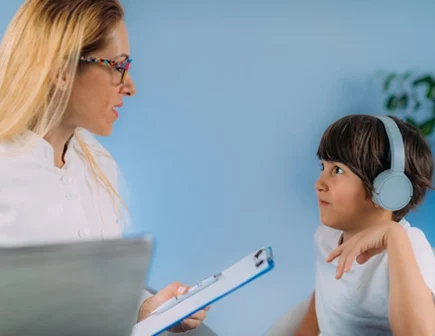Dear Parent
The Safe and Sound Protocol (SSP) of integrated listening is a non-invasive however potent therapy intervention tool to assist your child’s ability to gradually sustain an improved sense of calm, self-regulation, focus and spontaneous social engagement. At Hope-AMC the SSP is delivered as part of Occupational Therapy (OT) treatment sessions, and it is of utmost importance to understand that it is not a stand-alone tool that is used in isolation but rather, as part of a holistic OT treatment plan.
The SSP is inclusive of three (3) levels:
- The SSP Connect: Preparing the auditory processing sense (listening) for high sound frequency tolerance
- The SSP Core: The actual therapy intervention with high sound frequency music
- The SSP Balance: An ‘’after-care’’ program that can be administered at home and/or during therapy sessions
The individual needs of every child determine how we decide to provide the SSP. The SSP may be done during therapy sessions only, or with a combination of OT therapy and home sessions.
Your certified SSP provider/ OT, will decide and indicate to you how you should use the level of the SSP that was shared with you, for home use. Once the SSP is shared with you, you will receive an email from support@unyte-ils.com; this will provide you with a link that will enable you to download the SSP App on your smart phone, from where you may deliver the program as indicated below.
While using the SSP, there may be responses from your child that are important to monitor and, parents are encouraged to attach value to these symptoms and give immediate feedback on the symptoms to your SSP therapist, as this feedback will guide your therapist on how to adjust the SSP delivery.
You may communicate with your therapist making use of the Hope-AMC WhatsApp contact number +971 52 999 7075
These responses are not considered to be ‘’good’’ or ‘’bad’’, but rather an indicator of whether the SSP has an impact on the Autonomic Nervous System of your child.
Examples of these symptoms are:
- Your child may be more fatigued or tired after listening to the SSP as the program remains an exercise for the muscle of the eardrum
- More or less sensitivity to daily sounds
- Covering his/her ears while listening to the SSP
- More or less bowel movements (poops!)
- More or less irritability
- More or less hyperactivity
- More or less vocalization (making sounds) and/or movement of the lips, mouth and tongue
- More or less spontaneous social engagement e.g., eye-contact, smiles and laughter
- More or less attentive listening to instructions
- More or less playing and interacting with peers and friends
- Reported to be more or less ‘’calm’’ in the classroom
- Change in eating pattern and routine
- Change in sleeping pattern
What then, are you supposed to do at home when your child looks as if he/she is upset by the SSP?
The best is, to do the things you usually did up to now to calm your child, which may include but is not limited to:
- Deep and long hugs
- Holding and rocking your child
- Singing to your child
- A calm and relaxing bath
- Being in a room with soft and low lights and keeping it as silent as possible
- Watching a favorite song/ story together with your child, on a device with low volume
- Hugging or playing with a favorite toy
- Having a favorite drink
- …and whatever else you as a parent know will be able to calm your child
The importance of feeling SAFE
The most important thing to remember is that when we use the SSP, we want your child to ‘feel safe’.
This is the factor that will determine the pace or speed with which we deliver the SSP – we want your child as far as possible, to remain at the top of the ladder!
General Guidelines:
- Strictly follow the instructions as recommended below
- Under no circumstances should the SSP shared to other families and children; this is to protect others from using the program without the support of a certified practitioner. Due to the potency of the program, it may cause alarming symptoms when used unguided
- Do not be alarmed when your child is ‘’not listening’’ to the SSP as indicated below – rather report this to your therapist
- Remember to take note of, and report symptoms mentioned above, to your therapist – this is mentioned again due to the importance thereof when delivering the SSP
- Should you have any questions not covered by the information sheet, please do not hesitate to contact your therapist without any delay
Further Reading:
Things You Need to Know about Safe and Sound Protocol (SSP) (hope-amc.com)
Delivering the SSP at Home:
| SSP Program | Delivery Notes | Duration of Delivery |
| SSP Connect | May be delivered via:over-the-ear headphonesany speaker system at homewhile driving in the carAccess to ALL family members is acceptable i.e., siblings, parents, and caregivers | Any length of time as tolerated or preferred by your childCan be used dailyTo be used at least 3 times per week |
| SSP Core | Strictly to be used as indicated by your certified SSP provider/ therapist. Delivery may be adjusted as your child progress in using the SSP. It is preferred that this is delivered via over-the-ear headphones however, your therapist may indicate the use of a speaker: should this be the case, you (one parent specifically) would have been exposed to listening to the SSP Core during sessions prior to using it at home. | Strictly as indicated |
| SSP Balance | May be delivered via:over-the-ear headphonesany speaker system at homewhile driving in the carAccess to ALL family members is acceptable i.e., siblings, parents, and caregivers | Any length of time as tolerated or preferred by your childCan be used dailyTo be used at least 3 times per week |


